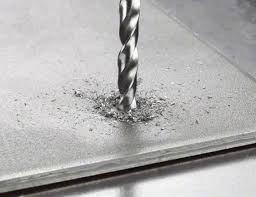In modern machining, manufacturing, and DIY engineering, the HSS Twist Drill Bit remains an indispensable drilling tool. Despite the emergence of new materials and composite drill bits, high-speed steel (HSS) drill bits are still widely used due to their heat resistance, toughness, and versatility. So, what are the unique advantages of HSS Drill Bits? Which materials are they suitable for drilling? How can they maintain precision during continuous drilling? We will explore these questions in depth, analyzing the technical features, usage tips, and development trends of Drill Bits.

Which materials are HSS Twist Drill Bits suitable for?
One of the biggest features of HSS Drill Bits is their wide material applicability.
| Material Type |
Drilling Performance |
Usage Recommendations |
| Carbon steel, Alloy steel |
Can be cut at high speeds while maintaining sharp edges |
Recommended to use cutting fluid for cooling to extend lifespan |
| Aluminum, Copper |
Smooth cutting, minimal particle adhesion |
Medium speed is sufficient; high-speed cutting requires chip removal attention |
| Wood |
Easy to drill through, high hole precision |
Use pointed drill bit design to reduce splintering |
| Plastic |
Cutting temperature rises easily, prone to melting |
Low-speed cutting and intermittent operation to prevent sticking |
The hardness and heat resistance of HSS drill bits allow them to maintain wear resistance during high-speed, high-temperature continuous drilling and are suitable for metals, wood, plastics, and more.
Advantages of High-Speed Steel Compared to Ordinary Steel Drill Bits
Compared to ordinary steel drill bits, HSS Bits have clear advantages:
1.High heat resistance: Maintain edge hardness even during high-speed drilling, less prone to dulling.
2.Strong toughness: Better impact resistance, reducing the risk of breakage.
3.Versatility: Suitable for a variety of materials, especially effective in metal machining.
4.High machining precision: Maintains consistent hole size, smooth hole walls, and facilitates subsequent processing.
These advantages make HSS a preferred tool in industrial production, mechanical processing, and laboratory operations.
How to Maintain Precision During Continuous Drilling?
During continuous drilling, drill bits may lose precision due to frictional heat, material hardness changes, or machine vibrations. Key measures include:
Proper speed control: Choose suitable speeds for different materials to avoid overheating, which can cause wear or hole deformation.
Use of cutting fluid: Cooling fluid lowers the drill bit temperature and removes chips, keeping the hole wall smooth.
Secure clamping: Ensure the drill is firmly held to prevent offset and vibration.
Periodic inspection: Check bit wear after long drilling sessions and sharpen or replace when necessary.
These practices help maintain high precision during continuous drilling and extend the service life of Drill Bits.
How to Extend the Service Life of HSS Twist Drill Bits?
Extending the life of HSS drill bits reduces costs and improves machining efficiency. Recommended methods include:
1.Proper usage: Select appropriate speed and feed according to the material, avoiding overheating or overload.
2.Use cutting fluid: In metalworking, use cutting oil or coolant to prevent drill bit failure due to high temperatures.
3.Correct storage: Keep drill bits in a dry environment to prevent rusting.
4.Timely sharpening: Sharpen dull edges promptly to maintain cutting efficiency and hole precision.
5.Prevent misuse: Avoid tilting the drill bit or hitting hard objects that could damage the edge.
Cleaning and Storage Tips for HSS Twist Drill Bits
HSS Drill Bits require proper care during cleaning and storage to maintain performance:
| Operation Step |
Method & Recommendation |
| Remove chips |
Use a brush or compressed air to remove metal shavings |
| Rust prevention |
Apply a small amount of anti-rust oil to prevent corrosion during long-term storage |
| Storage environment |
Keep in a dry box, away from direct sunlight and moisture |
| Classification |
Organize by diameter and use for easy access |
Proper cleaning and storage significantly extend the drill bit's lifespan and ensure precision in subsequent use.
New Materials and Coating Technologies for HSS Drill Bits
With advances in material science, HSS drill bits are continuously evolving:
1.Coating technologies: Titanium (TiN), black oxide, and titanium-molybdenum nitride coatings increase hardness, reduce friction, and extend service life.
2.High-performance alloy HSS: Adding cobalt (HSS-Co) enhances heat resistance, making it suitable for drilling high-hardness steel.
3.Particle-reinforced materials: Microstructural reinforcement helps drill bits maintain sharpness under continuous high-temperature conditions.
These innovations improve drilling efficiency while reducing heat buildup and wear.
New Requirements for High-Precision CNC Drilling
Modern CNC machines place new demands on HSS Twist Drill Bits:
High dimensional accuracy: Drill diameter and cutting-edge tolerances must be strictly controlled to ensure precise holes.
Strong wear resistance: Long-term high-speed rotation requires enhanced durability.
Good thermal stability: Prevent deformation and heat damage during high-speed drilling.
Automatic feed compatibility: Drill bits must withstand automatic loading/unloading, repeated drilling, and different material processing.
In CNC applications, the design and material of HSS drill bits directly affect machining precision and production efficiency.
Why Choose HSS Twist Drill Bits?
The main reasons for choosing HSS Drill Bits include:
Heat and wear resistance: Maintain sharpness during high-speed drilling, improving machining efficiency.
High versatility: Suitable for metals, wood, plastics, and other materials.
High machining precision: Stable hole diameter and smooth hole walls facilitate further processing.
Easy maintenance: Can be sharpened and coated to extend service life.
Cost-effectiveness: Offers high value compared to alloy or carbide drill bits.
Therefore, whether in industrial production, mechanical processing, or scientific research, Drill Bits remain indispensable tools.
As a traditional yet core drilling tool, Drill Bits continue to play a critical role in modern industry, mechanical processing, and high-precision CNC machining due to their heat resistance, toughness, and versatility. Through proper usage, cutting fluid cooling, regular inspection, and advanced coating technologies, HSS drill bits can significantly extend lifespan and improve machining efficiency.
Looking ahead, HSS Drill Bits will continue to evolve with material technology and smart manufacturing:
Application of more heat- and wear-resistant alloys for complex steel drilling.
Integration of smart production monitoring to track drilling temperature and wear in real time.
Advanced coatings and microstructural designs to improve efficiency while reducing energy consumption and waste.
HSS Drill Bits are not only fundamental industrial drilling tools but also key equipment driving advancements in modern manufacturing. Their applications will continue to be essential in both traditional factories and intelligent CNC workshops.








